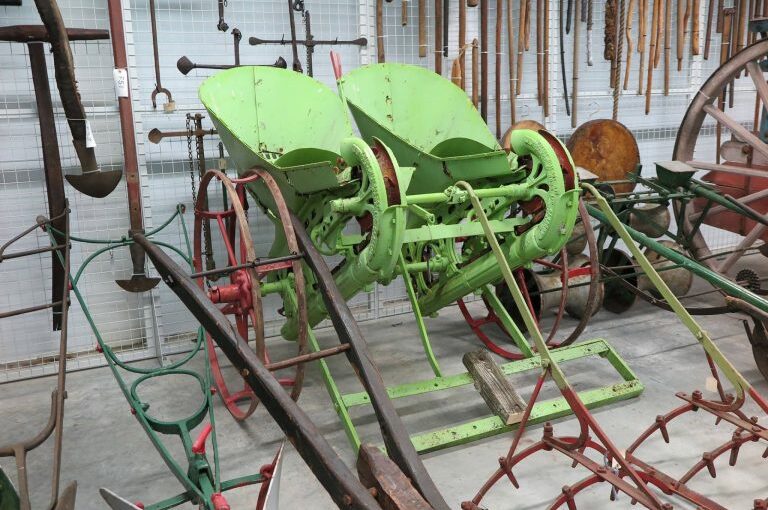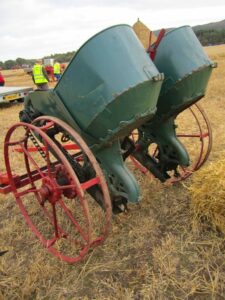The Richmond potato planter was developed by Mr Richmond of Dron, Fife before 1906. It came to be manufactured by John Wallace & Sons, Paton Street, Dennistoun, Glasgow, one of the major implement and machine makers in Scotland. It was first trialled in November 1906. The St Andrews Citizen reported on 17 November that:
“The inventor’s brain is never idle, and one of his latest products is another labour-saving implement to benefit the farmer. The potato-digger has revolutionized the old method of lifting the potato crop; and now we have a potato-planter that is evidently designed to effect a similar revolution in putting the seed into the ground. Such an implement is not altogether new; but practical men, who had an opportunity of seeing “Richmond’s potato planter” at work on Mr F. W. Christie’s farm of Dairsie Mains on Saturday, frankly acknowledged its superiority over anything yet devised. The inventor is well-known to Fife people as a daring rider at the Point-to Point races at Bruntshiels, and comes of an inventive race, his father, Mr Richmond of Dron, being the inventor of the Richmond drier. The high lying part of a field to the east of Dairsie Church, was prepared by Mr Christie for the exhibition trials, and among those taking a warm interest in the test were Mr Richmond himself, Mr Christie; Mr R. W. R. Mackenzie of Earlshall; Mr Orchison of Denbrae; Mr Millar and Mr Wm Millar, Nydie; Mr Bogie, Balass; Mr Fleming, Prestonhall, Mr McKerracher, Mayfield; Mr Dryburgh, Orkie, &c. The planter, which is constructed to cover two rows at a time, consists of two hoppers into which the seed is placed. Passing up through these hoppers are revolving chains with cups attached. As the chains go round, the cups take away the seed and deposit them on the bottom of the drill wonderfully steady, at an average interval of 10 to 12 inches. A feature of the implement which gained general approval is the manner in which it rectifies doubles. Owing to the elevation of the track along which the chain travels, and the shape of the cups themselves, any excess over the required seed are constantly thrown back into the hopper; and only a small percentage of doubles ever find their way through. The planter was first tested with whole Up-to-Dates, then with whole Langworthys (which owing to their shape occasioned the severest test), and finally with cut potatoes; and the machine came through each test with gratifying success. It is claimed for it that with a lad and a horse it can plant from 7 to 8 acres a day – the work of 7 to 8 people; and by means of a tilting lever, it can be readily adjusted to plant uphill or downhill. Representatives of Messrs John Wallace & Sons (Ltd), Glasgow, who are instructed with the sale of the implement were also on the ground giving information about its working.”
In 1908 the Richmond potato planter was awarded a silver medal by the Royal Highland and Agricultural Society of Scotland, following trials in the showyard of the Highland Show. It was also to be successful in that Society’s trial of potato planters held at Liberton Mains, Edinburgh, in March 1915. Some six machines were entered, and all took part in the Trial.
The following is the report of that trial, as published by that Society:
“Messrs John Wallace & Sons, Paton Street, Dennistoun, Glasgow, were represented by two machines: (number 3) A Two-Row “Richmond” Potato Planter—price, £15, 15s., and (number 4) a Single-Row “Richmond” Potato Planter—price, £15; the latter being also fitted with an Artificial Manure Distributor, consisting of a small hopper having a slowly revolving drum, and a forwardly inclined finger for distributing the manure.
The principle of action in the two machines is the same. The seeds are picked up from the hopper by a series of buckets or carriers, attached at spaced distances to an endless travelling chain, and elevated to a certain point where they are tilted into tubes by which they are delivered at regular distances apart into the drill or drills; these distances may be varied from 8 to 18 inches as desired. The buckets are formed of an open two-jaw shape, widest at the top part, and tapering downwards towards the centre; this formation of bucket stated to automatically select its own potato, and discard the remaining potatoes into the hopper. The endless chain passe: over a loose wheel or pulley situated at the curved pan: the hopper. The object of this pulley is to change the direction of travel of the buckets, which receive a “tip,” thereby
removing any potatoes other than the one actually in each bucket; the discarded potatoes falling back into the hopper. The top outer lip of each bucket is fitted with a loose mug, and should a potato get jammed in the bucket, this ring is pressed out, and when entering the hopper strikes a “ kicker, which causes the potato to be loosened, and ensures it being planted.
The shafts are movable, so that the horse can walk either on the top or in the bottom of the drill as desired. The work of No. 3 machine was, on the whole, very satisfactory. Even with the long-shaped and cut seed the work done was beyond the expectations of the Official Observers. The arrangement by which the shafts are movable, so as to enable the horses to walk either on the top or in the bottom of the drill, was considered to be a decided advantage.
The work of No. 4 machine appeared to be as near perfection as is possible by mechanical means. The working principle is identical with that of Machine N0. 3, but under the conditions under which the trial took place the Single machine showed to advantage. This implement also sowed the artificial manure, and in this and other respects may be regarded as a suitable machine for the small farmer.”
The Committee of Official Observers were, unanimously of opinion that the work done by the machines Nos. 3 and 4 was the best, the work done by No. 4 being particularly good. This superiority of the single-row machine may have been due to the fact that the drills were drawn somewhat narrower than the width to which the double machines had been set. The Committee are of opinion that it is desirable to have the machines adjustable to varying widths of drill, as 1t 18 frequently found desirable to vary the width, even on the same farm, to suit different varieties of seed.”
The Richmond potato planter continued to be widely used over the following decades. It continued to be found at displenishing sales into the 1940s and 1950s. In 1946 (13 November) The Scotsman noted them at Cauldcoats, Portobello (Mrs Gilchrist). In 1948 (23 October) it also noted one for sale at Lanark Auction Mart. The Aberdeen press and journal recorded one on 28 February 1948 at the Central Mart, Aberdeen. In 1950 (16 November) the Dundee courier reported one at Lumbennie, Newburgh (Mr Geo. Low). On 19 March 1951 it recorded one at Forfar Auction Mart.


